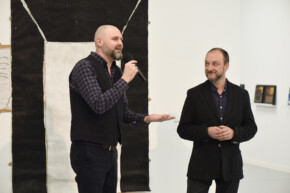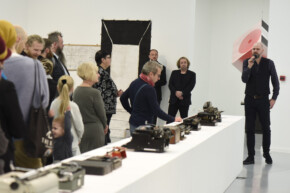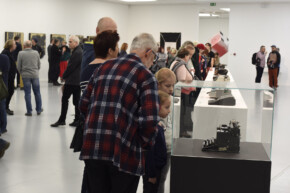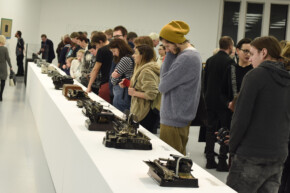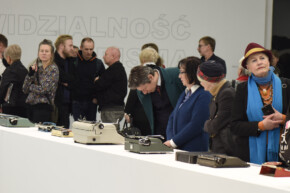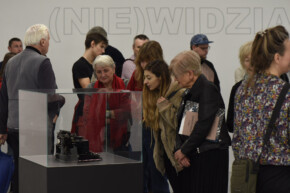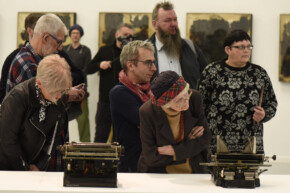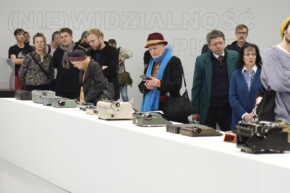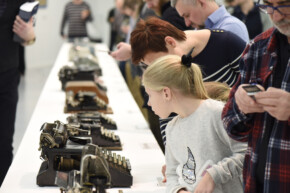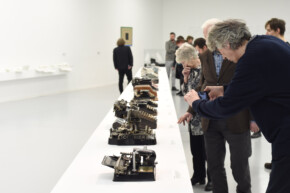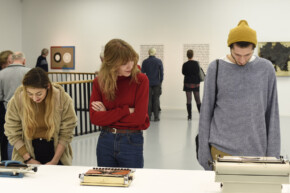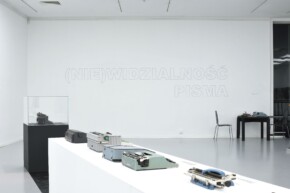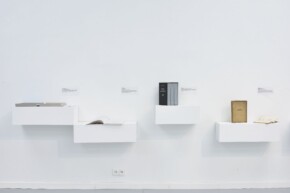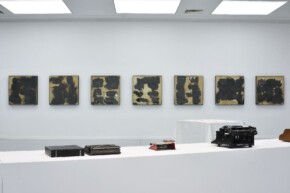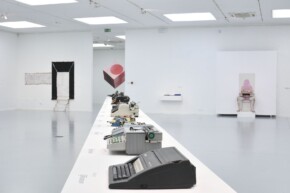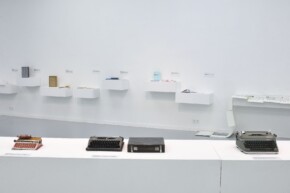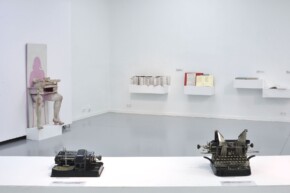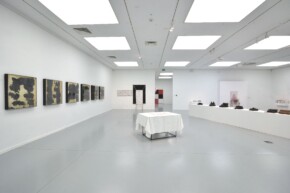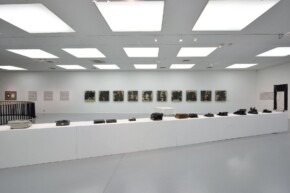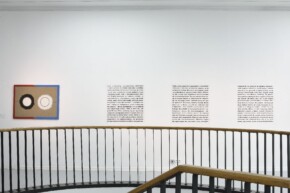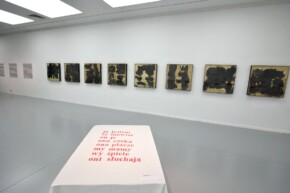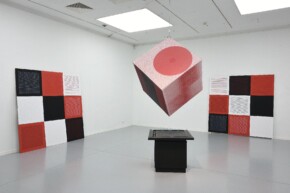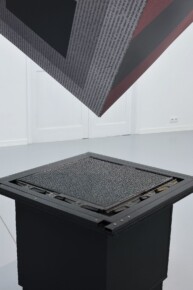We are people the late age of print, people of code, children of — at the same time — Gutenberg and Turing. Even this civilisation, which is so often and so recklessly called pictorial, has at its base (in its deep, deepest layers) strings of characters enchanted in a zero-one code. Our lives stretch between that zero and one. Just like they have stretched for ages between one letter and another, in this barely visible but infinite space. It is there — in this seemingly small space — that our lives still take place.
[0]
At a time when the death of writing, or even the death of the culture of writing is talked about most and most dramatically, writing proliferates most spectacularly in its entire history, it experiences its quantitative peak, it appears most insistently in its history (from TV news strips to the public space specked with signboards and advertisements). Letters have surrounded us, possessed us — never in history have humans written so much, and now they have turned into mad “typewriters.” And probably never in history have humans read so much — even if now they do it involuntarily and automatically (which can sometimes mean: thoughtlessly, with no reflection).
We, the people of the late — maybe the last one? or: coming to an end — age of print, have created for ourselves a world of (from) letters. The world which in turn creates us and changes us all the time, only that since we are immersed in the screens of our smartphones, on which these texts multiply, we may not notice it — because the letters have become invisible, just as the technologies of their writing and reading have become invisible. This was caused both by the excess of writing and the disappearance of its materiality.
That is the way it is: the civilisation that we have created is now creating us. Making writing material and visible again is unlikely to change anything any more — things have gone too far. But at least it will allow us to better understand ourselves. Or maybe even the world that awaits us? The fate that we have prepared for ourselves?
[1]
Perhaps the most obvious sign of the materiality of writing is the device that dominated the 20th century: the typewriter. Born in the 19th century, at the height of the development of industrial civilization, for over a hundred years the typewriter defined both office work and mass imagination — it became a symbol of writing, its sign, an icon of its time. Not to mention literature. For the typewriter has established itself between mechanical work and creativity, between technology and culture, constituting a specific link, medium and relay.
Eliminating the unique character of the manuscript and standardising the appearance of the typeface, the typewriter took a central place in the industrial civilisation, defining and emphasising its character. As something between a device (i.e. something that is a tool in human hands) and a machine (i.e. something that works by itself, transforming human thought and reproducing the concept of the object which is to be the effect of its work), the typewriter revealed the future. The computer — especially a laptop or a tablet — with its look reminiscent of the typewriter, is the typewriter’s child.
The renaissance of interest in typewriters that we are experiencing now is a natural reaction to the digital age and to the ease with which texts can be produced (and reproduced). Our bodies rebel against the instability and invisibility of the digital world. They want to leave material traces. They wish to survive, but also to find themselves in the space of writing, to find a safe place between thought and its physical, visible fulfilment. This “between” which — as we can see — is the recurring motif in the description of the machine civilisation, is the key to our understanding of such a civilisation: today, that which is between, we call “the interface.” An intermediary between man and technology.
[2]
The book also remains a sign of the materiality of writing. We live — as it is usually described — in the “the late age of print”, and we are witnessing a great, ground-breaking remediation (this is Jay David Bolter’s term). Remediation is the moment of change in the paradigm of the existence of writing as a representation of human thought; there have been several such processes in the history, each of them crucial for the development of our civilisation: transition from orality to handwriting; from stone and wood as recording space, to papyrus rolls; from rolls to manuscript codex book; from manuscript to printing. The last remediation so far has been the re-modelling of the space of writing which we now observe: from a printed book into its electronic version.
This latest remediation obliterates the impression of materiality of writing. It replaces the hard physicality of words with electronic fluidity, which fundamentally changes our thinking about the world and ourselves. It damages our sense of the stability of meaning. It eliminates what can be called the canon, the canonical version, the determined original.
The reaction to this is the development of literature which is usually referred to as ergodic (this is Espen Aarseth’s term), i.e. one that in the act of reading requires work that goes beyond the usual process of turning over subsequent pages and the movement of eyeballs that follow subsequent words. Books that are the carriers of such literature are called experimental or artistic, sometimes also — objects.
They take various shapes. Among them, there are box-books containing various forms of printing: sets of binders, notebooks, photos, artefacts. Among them, there are map-books that reproduce the physical space in paper. There are also rootstalk books, peculiar labyrinths that link the reader to spaces outside the book (some — such as books using QR codes — are a connection with virtual space). Finally, there are books that use old models of print presentation, going back to the earlier stages of development of the space of writing, from before the earlier remediations: rolls, stones, manuscripts.
Each of these books forces readers to make an effort to read, to put it bluntly: they require physical work that must accompany intellectual work. Each of these books makes our whole body involved in the reading process. And each of them proves that there are such ways of writing that cannot be transferred to virtual dimensions; that there are content and meanings possible only in physical form.
[3]
Restoring the visibility of writing can be an activity bound to lose in the face of the rapid development of digital civilisation. However, it does not have to be meaningless. And that is because it restores the human dimension of civilisation, shows its material sources, does not allow to separate the feeling of one’s own carnality from human thought and its products. And it also takes us from the space of impermanence, ephemerality and immediacy into the sphere of long duration. It settles us in the world. Restores the sense of reality. The typewriter, the art of book, as well as the art based on the book medium, save our frail and atrophy-endangered senses. That is why it is sometimes worthwhile to experience their durability and beauty.
Special thanks to
Muzeum Książki Artystycznej
Muzeum Narodowego w Krakowie
Muzeum Okręgowego im. Leona Wyczółkowskiego w Bydgoszczy
Narodowego Muzeum Techniki w Warszawie
curator: Michał Tabaczyński
arrangement: Bożena Januszewska, Marta Wiśniewska
coordination: Tomasz Zieliński
Start 22.01.2019, 6pm
20 Gdańska St.
End 17.02.2019


